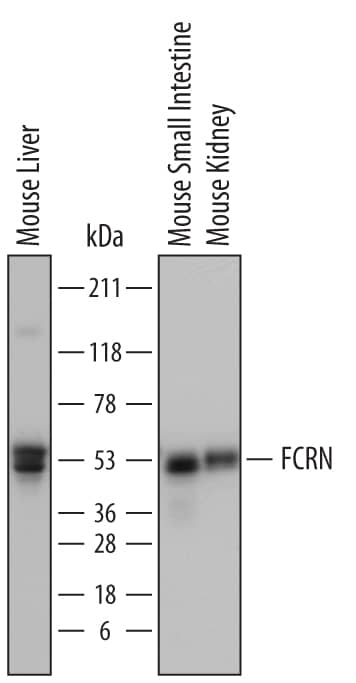Mouse FCRN Antibody
R&D Systems, part of Bio-Techne | Catalog # AF6775

Key Product Details
Species Reactivity
Validated:
Cited:
Applications
Validated:
Cited:
Label
Antibody Source
Product Specifications
Immunogen
Ser22-Ser301
Accession # AAH03786
Specificity
Clonality
Host
Isotype
Scientific Data Images for Mouse FCRN Antibody
Detection of Mouse FCRN by Western Blot.
Western blot shows lysates of mouse liver tissue, mouse small intestine tissue, and mouse kidney tissue. PVDF membrane was probed with 0.25 µg/mL of Goat Anti-Mouse FCRN Antigen Affinity-purified Polyclonal Antibody (Catalog # AF6775) followed by HRP-conjugated Anti-Goat IgG Secondary Antibody (Catalog # HAF017). Specific bands were detected for FCRN at approximately 48 to 55 kDa (as indicated). This experiment was conducted under reducing conditions and using Immunoblot Buffer Group 1.Detection of FCRN in J774A.1 Mouse Cell Line by Flow Cytometry.
J774A.1 mouse reticulum cell sarcoma macrophage cell line was stained with Goat Anti-Mouse FCRN Antigen Affinity-purified Polyclonal Antibody (Catalog # AF6775, filled histogram) or control antibody (Catalog # AB-108-C, open histogram), followed by Allophycocyanin-conjugated Anti-Goat IgG Secondary Antibody (Catalog # F0108). To facilitate intracellular staining, cells were fixed with paraformaldehyde and permeabilized with saponin.Applications for Mouse FCRN Antibody
CyTOF-ready
Intracellular Staining by Flow Cytometry
Sample: J774A.1 mouse reticulum cell sarcoma macrophage cell line fixed with paraformaldehyde and permeabilized with saponin.
Western Blot
Sample: Mouse liver tissue, mouse small intestine tissue, and mouse kidney tissue.
Formulation, Preparation, and Storage
Purification
Reconstitution
Formulation
Shipping
Stability & Storage
- 12 months from date of receipt, -20 to -70 °C as supplied.
- 1 month, 2 to 8 °C under sterile conditions after reconstitution.
- 6 months, -20 to -70 °C under sterile conditions after reconstitution.
Background: FCRN
FcRn (IgG receptor FcRn large subunit p51/ alpha-chain) is a 44-52 kDa member of the Ig superfamily. In mouse, it is expressed by intestinal epithelium of neonates and fetal yolk sac endoderm during pregnancy. Together with p14/ beta2-Microglobulin, FcRn forms an MHC I-like noncovalent heterodimer termed the FcRn complex. In rodent, FcRn transports IgG in milk into the intestine, and IgG from the mother's blood into the mouse via endodermal FcRn linked to a special Fc gammaRIIb macrophage receptor. It is also expressed by select macrophages and DCs, and participates in endosomal-associated antigen presentation to CD4+ T cells. Mature mouse FcRn is a 344 amino acid (aa) type I transmembrane glycoprotein. It contains a 276 aa extracellular region (aa 22-297) that contains an Ig-like domain (aa 201-288). The FcRn complex forms a homodimer when binding IgG. One potential splice variant shows a four aa insertion after Gly109. Over aa 22-301 of the splice variant (GenBank #:AAH03786), mouse FcRn shares 91% and 68% aa identity with rat and human FcRn, respectively.
Long Name
Alternate Names
Gene Symbol
UniProt
Additional FCRN Products
Product Documents for Mouse FCRN Antibody
Product Specific Notices for Mouse FCRN Antibody
For research use only

